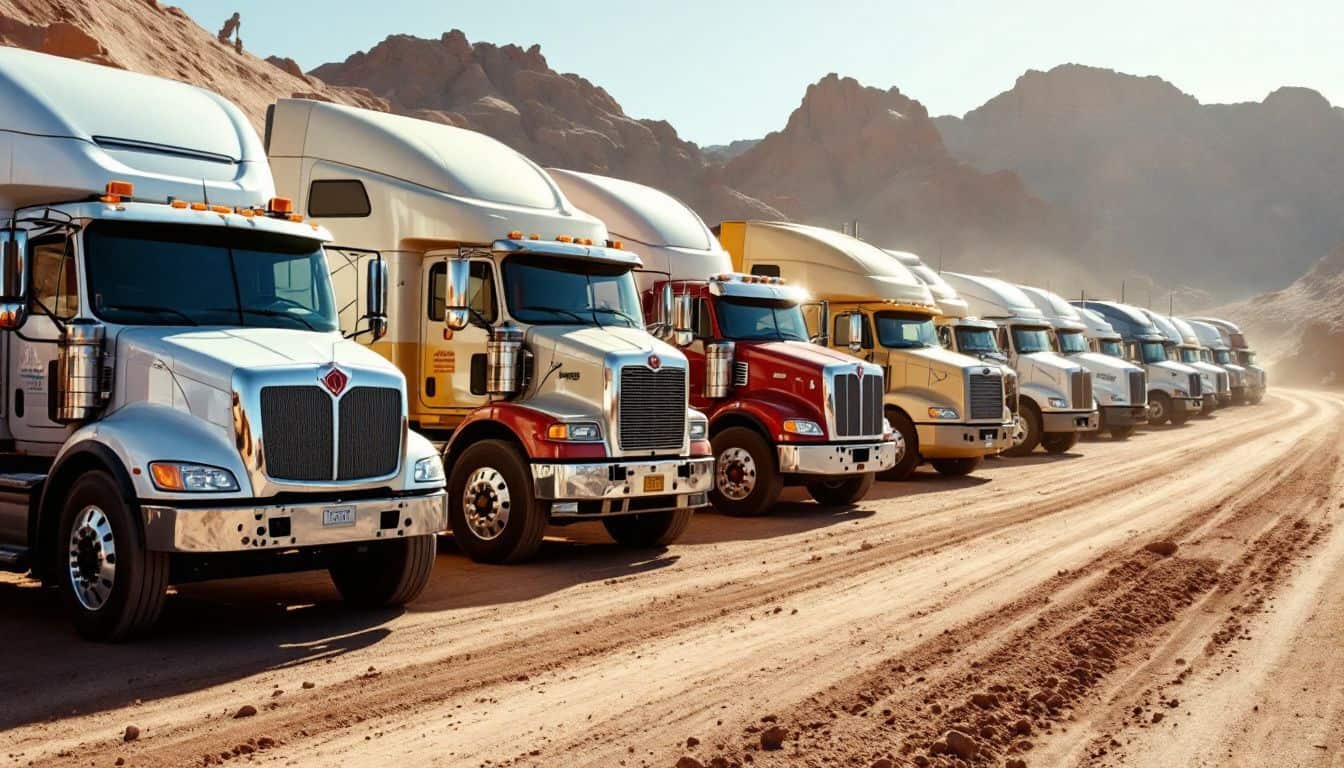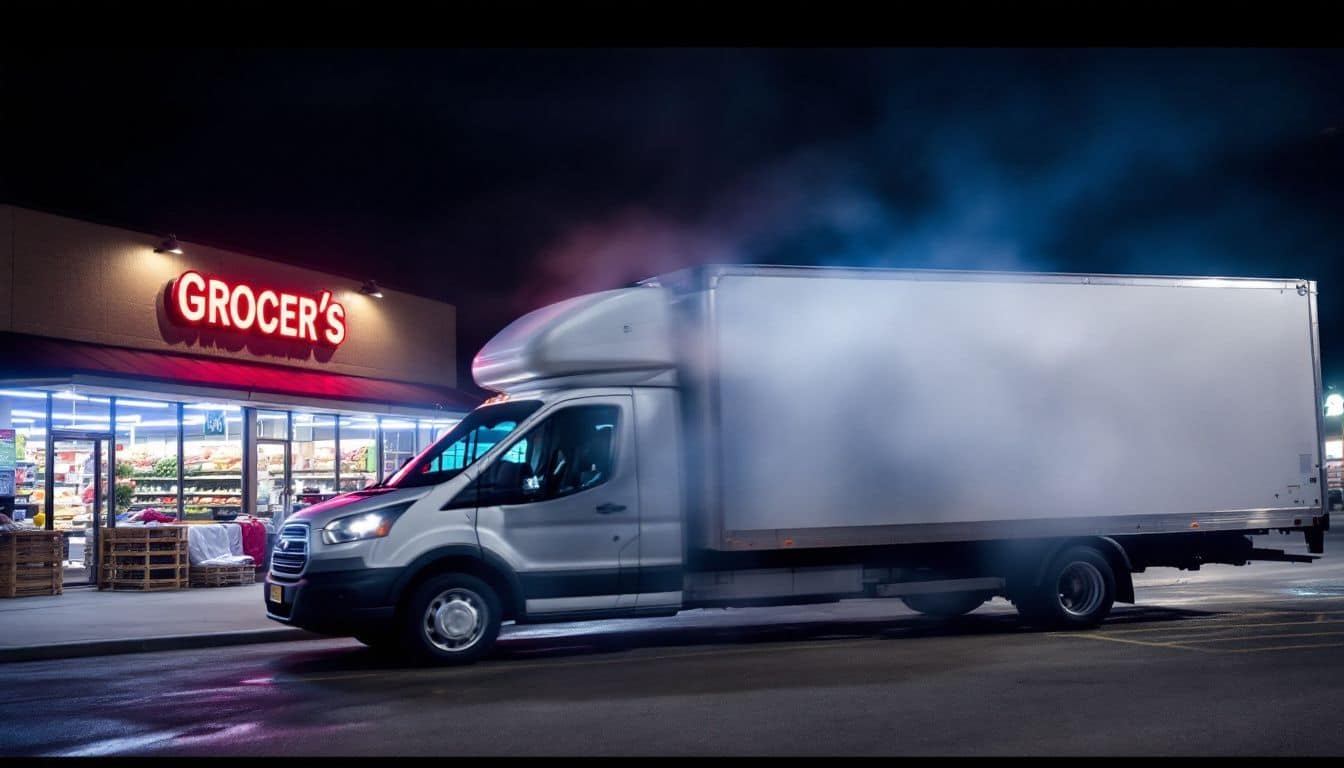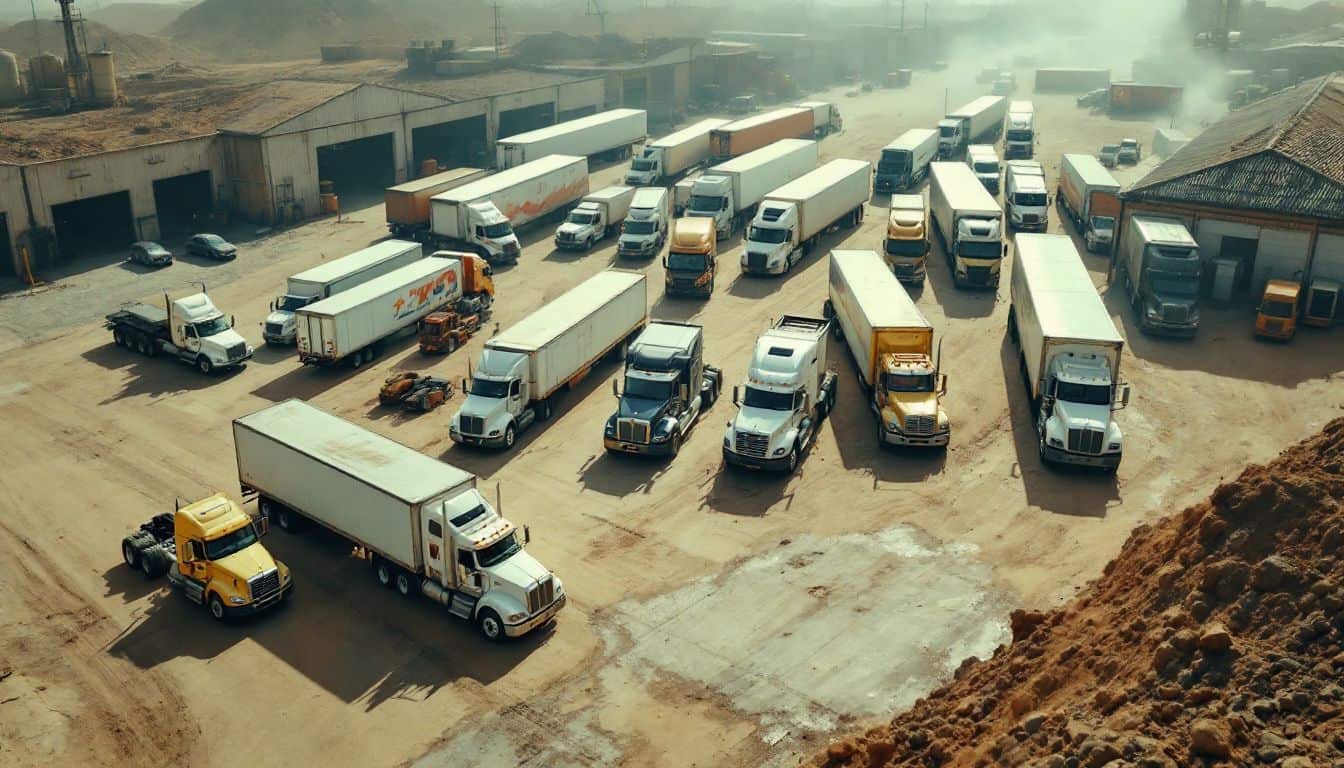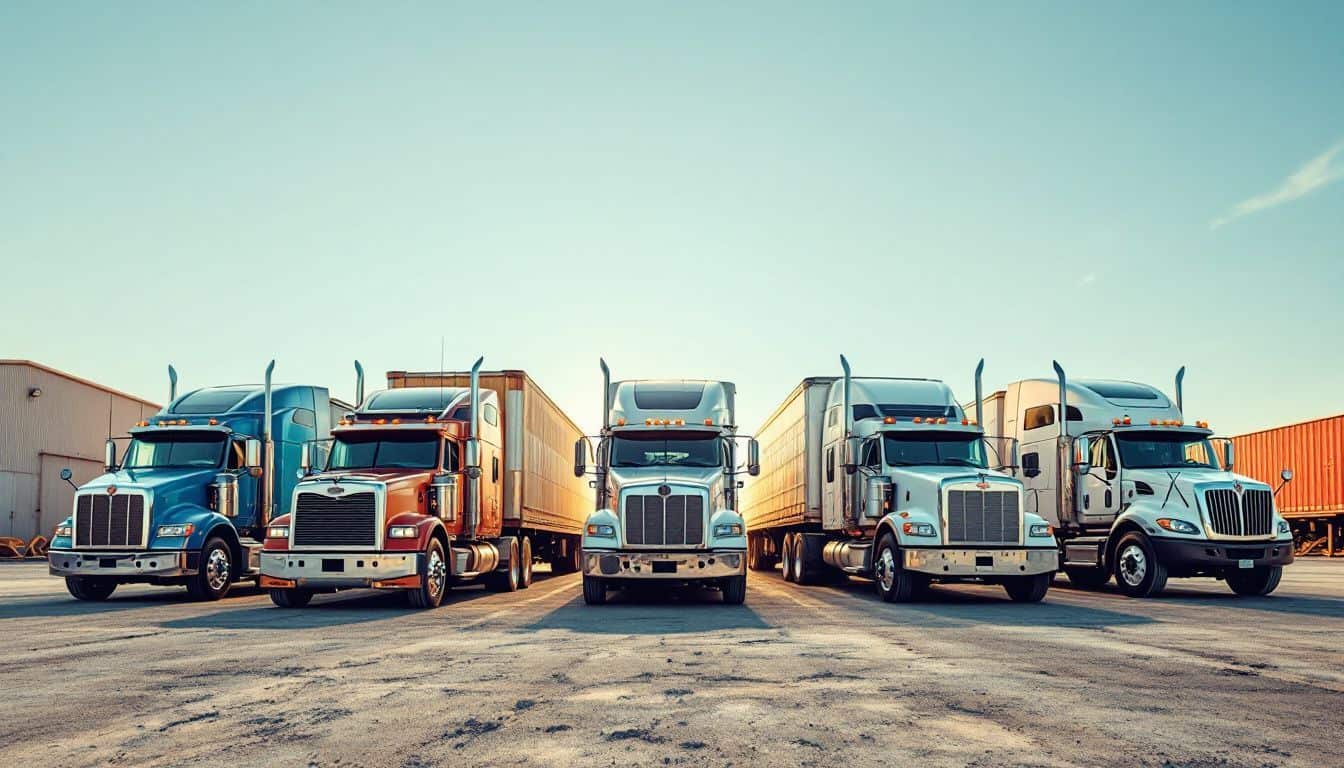Ever scratched your head over which truck to use for hauling? You’re not alone. Picking the right rig can make or break your transport game. There are seven main types of trucks for hauling, each with its own superpowers.
This guide will walk you through these road warriors, helping you choose your perfect match. Ready for a truck-tastic adventure?
Key Takeaways
Seven main types of trucks for hauling include semi-trailers, flatbeds, box trucks, tankers, refrigerated trucks, dry bulk tankers, and dump trucks.
Semi-trailer trucks can haul up to 80,000 pounds, while box trucks max out at 26,000 pounds. Flatbed trucking pays more at $3.07 per mile versus $2.27 for dry vans.
Refrigerated trucks, or “reefers,” transport about 70% of food in the U.S. and have been around since 1925. Some can reach temperatures as low as -150°C.
Electric trucks are becoming more popular for their fuel efficiency and lower maintenance costs, especially for city deliveries. However, diesel trucks still dominate long-haul routes.
Future trends in trucking include more electric and self-driving trucks, which could make hauling safer and more efficient while reducing pollution.
Table of Contents
Exploring Common Truck Types for Hauling

Let’s talk about hauling trucks. These road warriors come in all shapes and sizes – each with its own special ability.
Semi-Trailer Trucks: Essentials and Uses
 Semi-trailer trucks are the workhorses of the road. These big rigs, also called 18-wheelers, haul most of the goods we use daily. They’re built for long trips and can carry huge loads.
Semi-trailer trucks are the workhorses of the road. These big rigs, also called 18-wheelers, haul most of the goods we use daily. They’re built for long trips and can carry huge loads.
The front part, called the tractor, hooks up to a trailer using a special hitch. This setup lets truckers swap trailers easily, saving time and money.
These trucks are super flexible. They can haul one or even two extra trailers for more cargo space. The most common type in the U.S. is the Class 8 tractor trailer. Over half of long-haul fleets use the Freightliner Cascadia model.
It’s a favorite for its reliability and fuel efficiency. As a trucker once told me:.
My Cascadia’s like a second home. It’s comfy, tough, and gets the job done every time.
Flatbed Trucks: Versatility in Hauling

Flatbed trucks are the Swiss Army knives of the trucking world. These open-deck beasts can haul just about anything – from lumber to bulldozers. Picture a 53-foot-long, 102-inch wide platform on wheels.
That’s your typical flatbed. They’re perfect for those big, bulky items that won’t fit in a box truck. Farmers love ’em for hauling hay bales, while construction crews use them for beams and pipes.
But here’s the kicker – flatbed trucking pays more. On average, you’ll pocket $3.07 per mile, compared to $2.27 for dry vans. It’s not all sunshine and rainbows, though. You’ve got to be a pro at securing loads.
Nylon straps and chains with binders are your best friends. And don’t forget those DOT rules for oversized loads. They’re as strict as a drill sergeant. But if you can handle it, flatbed trucking offers a mix of challenge and reward that’s hard to beat.
Box Trucks: Compact Solutions for Transport

Box trucks are the unsung heroes of local transport. These compact haulers, with their box-like cargo areas, excel at city deliveries and tight spots. Costs range from $50 to $150 daily for light-duty models, while heavy-duty versions run $200 to $400.
They come in flavors like standard, dry freight, and even refrigerated for those temperature-sensitive loads.
I once rented a box truck for a cross-town move. It was a breeze to drive and park – way easier than those big rigs! But heads up, fellas: if you’re eyeing the bigger box trucks, you might need a CDL.
These babies can haul some serious weight, and the law wants to make sure you know your stuff before hitting the road.
Tanker Trucks: For Liquid and Gas Transport

Moving from compact box trucks, let’s shift gears to tanker trucks – the big boys of liquid and gas transport. These road giants are the go-to for hauling everything from fuel to milk.
They’re not just big; they’re mighty. Tanker trucks can lug around 1,000 to a whopping 11,600 gallons of liquid or gas. That’s like carrying a small pond on wheels!
Tankers come in all shapes and sizes. The big ones, holding 5,000 to 11,600 gallons, often have multiple compartments. Think of them as moving apartment buildings for liquids. Smaller tankers, carrying 1,000 to 3,000 gallons, are perfect for city deliveries.
They zip through tight streets like nimble cats. Different cargos need different tanks too. You’ve got your basic Cargo Tank Trucks, tough Corrosive Cargo Tanks, and high-tech Compressed Gas Cargo Tankers.
Each type is built to keep its special cargo safe and sound on the long haul.
Specialized Trucks for Specific Hauls

Specialized trucks are the unsung heroes of specific hauling jobs. These road warriors handle everything from chilled goods to loose materials. Want to know which truck fits your unique haul? Keep reading – you’re in for a wild ride!
Refrigerated Trucks: Keeping Goods Cool

Refrigerated trucks, or “reefers,” are the unsung heroes of our food supply. These cool customers haul about 70% of the grub we munch on in the U.S. It’s hard to believe, but we’ve only had these chilly chariots since 1925, thanks to Frederick McKinley Jones.
Today, there are roughly 500,000 reefer units cruising American roads, keeping our eats fresh from farm to table.
But reefers aren’t just for food. Some can get as cold as -150°C – that’s colder than Antarctica! These super-chillers are perfect for moving sensitive medical supplies. And talk about tough… a well-kept reefer can last 10–15 years on the road. That’s a lot of miles of cool! Learn more at https://www.divinetrans.com/page/reliable-company-for-transportation-temperature-controlled-goods about how these trucks keep your goods frosty fresh.
Refrigerated trucks are the coolest thing since sliced bread – literally keeping that bread fresh on its journey to your sandwich!
Dry Bulk Tankers: Transporting Loose Materials

Dry bulk tankers are the unsung heroes of the trucking world. These big rigs haul massive amounts of loose stuff like grain, cement, and even sugar. They’re super efficient, moving up to 3,000 gallons of dry goods at once.
That’s a lot of cookies! But it’s not all fun and games. Safety is key when dealing with these powdery loads. Drivers need to make sure everything’s locked down tight before hitting the road.
These trucks are a smart choice for moving bulk materials. They cut down on packaging waste and save cash in the long run. Plus, they’re better for the planet. But don’t think just anyone can hop in and drive.
You need special skills and a commercial driver’s license to handle these beasts. It’s a tough job, but someone’s gotta do it!
Dump Trucks: Moving Large Quantities of Materials

Dump trucks are the workhorses of construction sites and quarries. These beefy vehicles haul massive loads of dirt, gravel, and other materials with ease. Side dump trucks, rear dump trucks, and bottom dump trucks each have their own special way of unloading.
But they all share one thing – the ability to move tons of stuff fast. Since 2017, trucking companies must follow Electronic Logging Device rules. This helps keep track of how long drivers work and makes sure they stay safe on the road.
Dump trucks aren’t just for moving earth. They also transport concrete, asphalt, and even garbage. Their sturdy build lets them carry heavy loads over rough terrain. Some can even tow other equipment like weird trucks or excavators.
With different sizes and styles, there’s a dump truck for every job. From small local projects to big highway builds, these trucks keep things moving.
Key Factors in Choosing the Right Truck

Picking the right truck isn’t just about size. It’s about matching your needs to the truck’s abilities – and that’s where things get interesting. Let’s dive into what makes a truck the perfect fit for your hauling job.
Assessing Cargo Needs

Picking the right truck starts with knowing your cargo. Let’s dive into the key points for sizing up your hauling needs:
- Weight matters: Check how heavy your load is. A semi-trailer can handle up to 80,000 pounds, while a box truck might max out at 26,000 pounds.
- Size it up: Measure your cargo’s length, width, and height. Flatbeds are great for oversized equipment, but box trucks work better for smaller, stackable items.
- Fragile or tough??: Delicate goods need more protection. Box trucks offer enclosed spaces, keeping your cargo safe from the elements.
- Temperature control: Some goods need to stay cool. Refrigerated trucks keep perishables fresh during transport.
- Liquid or solid?: Tanker trucks are built for fluids and gases. Dry bulk tankers handle powders and granular materials.
- Local or long-haul?: Short trips might only need a box truck. Cross-country hauls often require semi-trucks for efficiency.
- Loading ease: Think about how you’ll get cargo on and off. Flatbeds allow for easy forklift access from all sides.
- Special needs: Hazardous materials require specific truck types. Make sure you’re following all safety rules.
- Frequency of trips: Regular hauls might justify owning a truck. Occasional needs could make renting more cost-effective.
- Future growth: Consider your business plans. Investing in a larger truck now might save money down the road.
Route and Terrain Considerations
Picking the right truck for your haul isn’t just about the cargo. You’ve got to think about the roads you’ll travel, too. Here’s what to keep in mind:
- Highway vs. city driving: Long, straight highways call for different trucks than tight city streets. Semi-trucks shine on interstates, while box trucks might be better for urban deliveries.
- Mountain passes: Steep grades need trucks with strong engines and good brakes. Flatbeds or semi-trucks with powerful engines are often the go-to for mountain routes.
- Weather conditions: Icy roads or heavy rain can be tricky. Trucks with all-wheel drive or special tires might be needed for slippery conditions.
- Road quality: Smooth highways are a breeze, but bumpy back roads need tougher trucks. Dump trucks or heavy-duty semis can handle rough terrain better.
- Bridge and tunnel limits: Some routes have height or weight restrictions. Box trucks or smaller semis might be needed to fit under low bridges or meet weight limits.
- Fuel efficiency: Long hauls on flat roads? An aerodynamic semi might save you gas money. Short trips with lots of stops? A smaller truck could be more fuel-friendly.
- Loading zones: Think about where you’ll pick up and drop off. Some places might not have loading docks, so a truck with a liftgate could be a lifesaver.
- Traffic patterns: Rush hour in big cities can be a nightmare for huge trucks. Smaller, more maneuverable vehicles might be better for busy urban areas.
Now that we’ve covered the road, let’s talk about what really matters – the bottom line.
Evaluating Cost Efficiency
Hauling and money go hand in hand. Smart truckers know this well. They’re great with numbers. Let’s look at the cost efficiency for different truck types.
| Truck Type | Initial Cost | Fuel Efficiency | Maintenance | Long-term Value |
|---|---|---|---|---|
| Semi-Trailer | High | Moderate | Regular | Excellent |
| Flatbed | Moderate | Good | Low | Very Good |
| Box Truck | Low | Very Good | Low | Good |
| Battery Electric | Very High | Excellent | Low | Promising |
Big rigs cost a lot upfront. But they haul more, making each trip count. Flatbeds? They’re the middle ground – decent price, solid performance. Box trucks are cheaper and good on fuel. Now, here’s the kicker – battery electric trucks. They’re expensive now, but boy, do they save on fuel!
I’ve seen it firsthand. My buddy Jake switched to an electric rig last year. His wallet took a hit at first, but now he’s saving big time. Fuel savings are no joke.
But hey, it’s not just about the price tag. Think long-term, fellas. Maintenance costs can add up fast. Electric trucks? They’re easy to maintain. Fewer moving parts mean fewer problems.
Route matters too. Long-haul? Diesel still dominates. But for city deliveries, electric trucks are getting popular. It’s all about matching the truck to the job.
Being a savvy truck driver isn’t just about skill behind the wheel. It’s about making smart choices that keep more money in your pocket. So, do your homework and pick the rig that’ll be good for your wallet in the long run.
Future Trends in Trucking and Hauling

Trucking is changing fast. Electric trucks are the new big thing. Major companies are putting money into making these eco-friendly haulers. They’re quiet, clean, and cost less to run.
I’ve seen them on the road, and they’re pretty cool. Plus, they help cut down on pollution. It’s a win-win for truckers and the planet.
Tech is also shaking things up in the truck world. Self-driving trucks are on the horizon. They could make long hauls safer and more efficient. But don’t worry, drivers. You’re still needed.
These trucks will need skilled pros to manage them. It’s like having a high-tech co-pilot. The job might change, but it’s not going away. Trucking’s future looks bright and full of new chances.
People Also ask
What are the main types of trucks used for hauling?
The trucking industry uses seven key types: semi trucks, flatbed trailers, refrigerated trucks, dump trucks, tanker trucks, box trucks, and tow trucks. Each has its own special job in moving goods around.
How do refrigerated trucks keep things cold?
These cool cats use special climate control systems to keep perishable goods fresh. They’re vital for the cold chain, stopping food from going bad during long trips. It’s like a giant fridge on wheels!
What’s the deal with flatbed trailers?
Flatbeds are the workhorses of the road. They haul big, odd-shaped stuff that won’t fit in regular trailers. Think construction materials or machinery. They’re open-air, so cargo gets strapped down tight.
Why do some trucks have that funny-looking coupling?
That’s the fifth-wheel coupling! It connects the tractor unit to the semi-trailer. It’s super strong and lets the trailer pivot. This setup makes those long rigs more manoeuvrable on the road.
What’s the difference between full truckload and less than truckload?
Full truckload is when you fill up the whole truck with one shipment. Less than truckload is like carpooling for cargo – different shipments share space. It’s cheaper but takes longer.
Do truck drivers need special licenses?
You bet! Most need a commercial driver’s license (CDL). For some trucks, like those carrying hazmat materials, drivers need extra certifications. It’s not just hopping in and hitting the gas!
References
- https://blog.truckerguideapp.com/post/7-types-of-freight-trucks-hauling (2023-05-27)
- https://www.dat.com/resources/the-ultimate-guide-to-flatbed-trucking
- https://www.inboundlogistics.com/articles/box-trucks/
- https://pushlimitslogistics.com/blogs/guides/types-of-box-trucks-a-comprehensive-guide?srsltid=AfmBOorTAxfyNvfd-DaQwz5WQQUwECx8OZVieCXCW8S_9sWROCNAK4UQ
- https://www.inboundlogistics.com/articles/tanker-trucks/
- https://dragonproducts.com/types-of-liquid-tanker-trailers/ (2023-04-27)
- https://www.inboundlogistics.com/articles/refrigerated-trucks/ (2024-02-22)
- https://qualitycarriers.com/dry-bulk/what-is-dry-bulk-trucking/ (2024-01-29)
- https://www.hbrown.com/the-7-major-types-of-hauling-equipment
- https://www.truxnow.com/blog/types-of-dump-trucks
- https://www.charymachinery.com/important-tips-to-choose-the-right-cargo-truck-easily.html (2024-05-29)
- https://www.cardermotors.com/how-to-choose-the-right-truck-for-your-needs.htm
- https://roadtrippers.com/magazine/whats-the-best-truck-for-towing-a-travel-trailer/
- https://rosap.ntl.bts.gov/view/dot/62539
- https://trucksalesnj.com/a-step-by-step-guide-on-how-to-choose-the-right-truck-for-your-business/
- https://www.cloudtrucks.com/blog-post/trucking-trends (2023-12-26)

